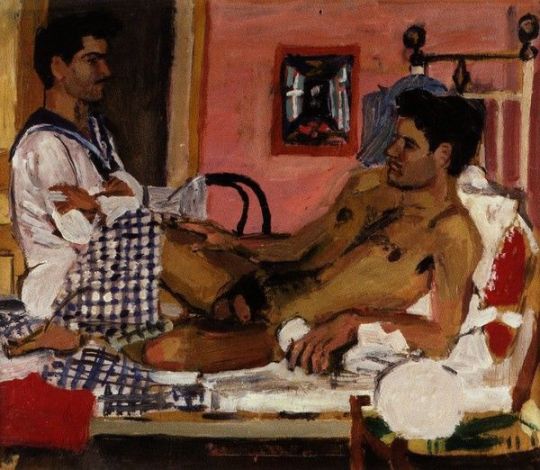Text

Boris Vasilievich Korneev (1922 – 1973). "Sitting Lad", 1954. oil on canvas
48 notes
·
View notes
Text

Polykleitos Rengos (Greek, 1903-1984). "Portrait of Jean", c. 1925. oil on canvas
196 notes
·
View notes
Text

Physique magazines didn’t need to announce themselves as gay, even if they had been able to. Their readers recognized what we now think of as a “gay gaze”: appreciative, even avid, but not uncritical; at once warm, cool, and knowing. As a result, many of the best physique photographs are portraits, but even when we’re not looking into their faces, the men are tantalizingly alive. Readers understood the necessity of balancing discretion and seduction, subtlety and audacity. Early physique photographers took classical statuary as their inspiration and Hollywood glamour portraits as their models for lighting and setting. Some of the men who posed were professional bodybuilders, including stars of the international circuit, but most were handsome athletes, aspiring actors, well-built ex-marines, or models looking to augment their portfolios: men who had reason to keep their bodies in great shape. Because a number of the most successful photo studios were based in Los Angeles, photographers could choose from a large and constantly replenishing population of young men anxious to be recognized, to be chosen. Obscenity laws, most aggressively enforced by the U.S. Postal Service, attempted to keep that excitement within bounds—no uncovered or obviously aroused penises, no affectionate or suggestive physical contact. Pushing those boundaries gave the best physique work a subversive edge. Although these were hardly outlaw enterprises, the liveliest of them had a rock-and-roll sensibility: rules were made to be broken. Models wore thong-like modified jockstraps to cover their genitals, leaving little to the imagination, but that little was enough to rivet us readers; any evidence of bulge was the focus of fevered attention. The models were named, along with the studios, most of which advertised photographs for sale on the back pages. These studios were rarely larger than a one-car garage, but the photographers’ results were as unique as their signatures. For work that was essentially commercial, the images are often unexpectedly touching, especially in scenes of men holding hands, deliberately blurring the line between friends and lovers. Physique photographers may not have considered themselves outsider artists, but for years these photographs remained private—shared among a population of men who were just beginning, against all odds, to frame a public identity. The past they represent is a queer utopia, a safe space for erotic fantasy. No wonder they drove the postal authorities crazy. Full article: "The Secrets of Physique Magazines" [The New Yorker]
61 notes
·
View notes
Text

"Marin assis et nu allongé" (1948) by Yannis Tsarouchis.
Follow RedSanctum
145 notes
·
View notes













